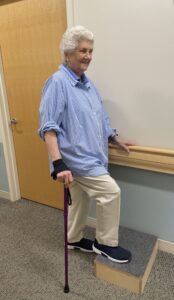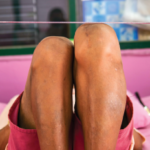
Figure 3
The cane always moves with the involved leg.
Conclusion
Canes are important tools to help people stay on their feet, minimize sedentary behavior, move and lubricate joints and muscles, and foster better joint and muscle health. The third point of floor contact provided by a cane can help prevent falls, especially for older adults. Providing a cane at a healthcare appointment may optimize individuals’ use of a cane.
Yvonne Golightly, PT, MS, PhD, is a professor and assistant dean for research at the University of Nebraska Medical Center College of Allied Health Professions, Omaha. She is a musculoskeletal epidemiologist and a physical therapist with 20 years of experience in research and over a decade of clinical practice.
Aileen Ledingham, PT, MA, PhD, is a physical therapist at Mount Auburn Hospital, Cambridge, Mass., where she specializes in rheumatology, particularly physical therapy for older patients with knee issues. She also serves as the 58th president of the Association of Rheumatology Professionals.
Acknowledgment
The authors thank Anna Lawrence for her assistance in the development of this article.
References
- Physical Activity Guidelines for Americans, 2nd edition. Washington, D.C.: U.S. Department of Health & Human Services; 2018. https://health.gov/sites/default/files/2019-09/Physical_Activity_Guidelines_2nd_edition.pdf.
- Mayo Clinic. Tips for choosing and using canes. 2023 May 26. Accessed 2024 May 23. https://www.mayoclinic.org/healthy-lifestyle/healthy-aging/in-depth/canes/art-20548206.
- How to choose the right cane. Arthritis Foundation. (n.d.) https://www.arthritis.org/health-wellness/healthy-living/managing-pain/joint-protection/how-to-choose-the-right-cane.
